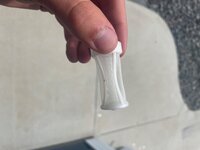I watch my fuel lines on every cold start. It helps me learn about fuel air mixture and its affects on how the engine is running. You can see why an engine stumbles as it warms up. Black lines are not perfect either. Traditional black fuel line does get hard. I have had a black fuel line leak. I left the black supply line between carbs, and the only reason I caught the leak was because I pressure tested two carbs at the same time that were connected together. I I won't argue about the quality of Yamahas fuel line because I can see it is very good, but it doesn't help find a leak in the pickup, selector, damaged barb, O-ring or the hose itself. Those leaks will seize an engine also. You don't have to look under the dash to see if air is getting into the carb...just look at the line to the carb.Been doing this for over 30 years so take it for what it is worth.
I have seen countless engines seized from the crap clear fuel line. Yes, when new you can see air leaks. As it ages and gets hard it always develops air leaks or it breaks off from the engine vibrations. But nobody checks for leaks after they install it so when it gets hard in a year and starts pulling air up under the dash on the fuel selector where you can't see it then on a WOT run across the lake your engine seizes.
The black fuel line doesn't get hard and makes a better seal on all the fittings, it just doesn't leak if you install it correctly with good quality zipties. You can also use your pop-off tester to put a few psi into the fuel system and see if the pressure drops to check for leaks so you can verify your fuel selector and fuel strainer are not bad along with your connections.
Bottom line all the clear hose will get brittle, hard and eventually leak. You could use genuine Tygon hose but you are just as good off with standard black automotive line. If you want the best of the best then use Motion Pro Premium Fuel Hose. It is what Yamaha uses on their watercraft and I have some that is 35 years old and still soft and pliable.
The bottom line is that if you have black lines you should have the system pressure tested as a regular maintenance item. If you have clear lines watch the line going to the carb regularly. Pick your poison




